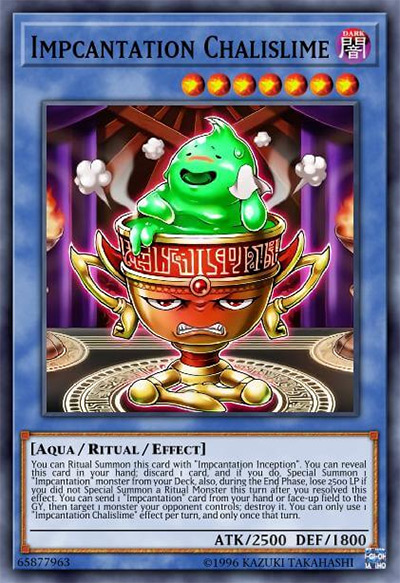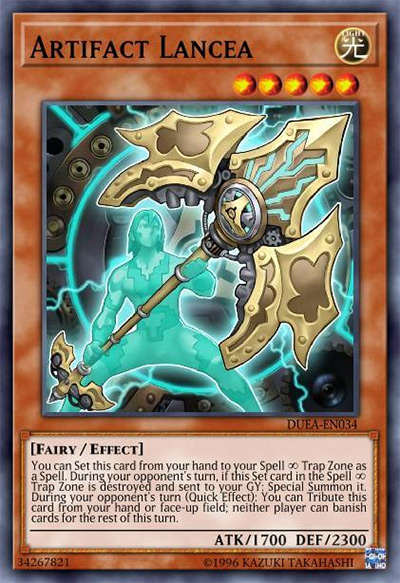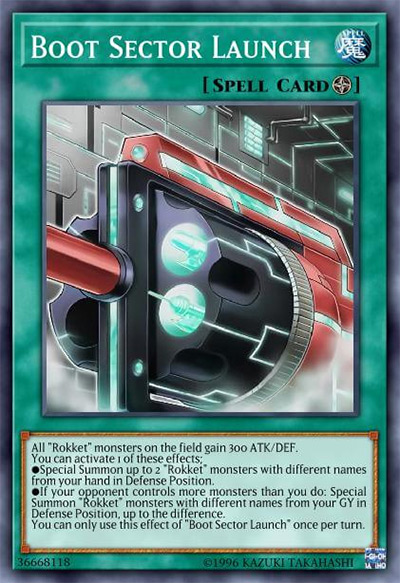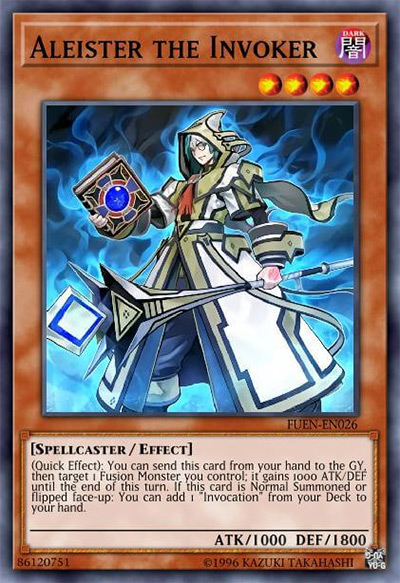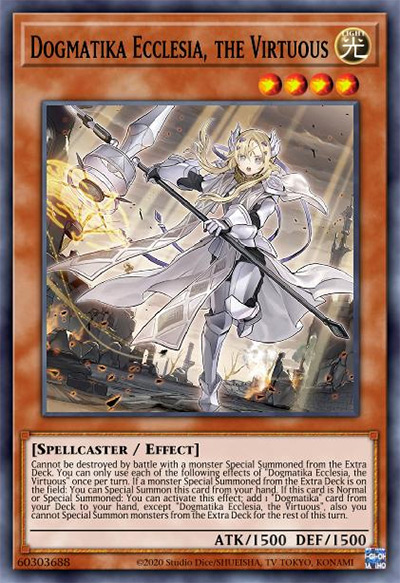An Engine in Yu-Gi-Oh! is simply a group of cards that slot into your deck to speed it up, or to provide card effects that you otherwise wouldn’t be able to access. These engines are typically outside of the archetype you’re playing – for example, although you may be playing a Dragon-link deck, you may want to use the Dogmatika engine to add some more swarming power. And if you’re looking for some generic engines to splash into your deck, well look no further, as we’re breaking down our picks for the top 5 engines in modern Yu-Gi-Oh!
5. The Impcantation Engine
A lot of ritual decks really struggle with consistency. It’s surprisingly tricky to draw both of the pieces you need for a ritual summon at the same time. The Impcantation deck works amazingly well at adding some generic search power to your ritual deck, allowing you to pull off some crazy ritual summons. For this engine, you’ll want to run the following cards:
Impcantation Chalislime (3 copies, you want this guy in your hand as much as possible) Impcantation Candoll (2/1 copies, searches from the deck) Impcantation Talismandra (2/1 copies, searches from the deck) Impcantation Inception (1 copy)
To start this combo off you’ll need Impcantation Chalislime in your hand. Lucky for us, it’s a level 7 ritual monster – meaning it’s searchable off of Preparation of Rites, a staple spell card in any ritual deck. By revealing Impcantation Chalislime in your hand, you can then special summon Impcantation Candoll from the deck. When Candoll is summoned you can then add any ritual spell from your deck to your hand, which you’ll want to use to search the one copy of Impcantation Inception in your deck. Then ritual summon any monster in your hand using Impcantation Inception (yep, this ritual spell can actually ritual summon any ritual monster, so go wild!) With this spell in the graveyard, you can then use Impcantation Inception’s graveyard ability to special summon Impcantation Talismandra from your deck – when this guy’s summoned to the field, you can search any ritual monster you like to add it from your deck into your hand. This is a nifty way of getting those key ritual monsters into your hand whenever you need them, so you don’t have to worry about drawing the right pieces. All the cards in the Impcantation arsenal are incredibly versatile, too. So even if you don’t pull off this exact combo, there are thousands of other ways you can use these guys to search out the best bits from your deck.
4. The Artifact Engine
This engine is a lot smaller than the previous one, meaning if you’re running low on deck space then this is perfect to try out. For this engine you’ll need to run:
Artifact Sanctum (3 copies) Artifact Lancea (1 copy) Artifact Scythe (1 copy)
Artifact Sanctum is a neat little trap card that lets you special summon any artifact monster from your deck to your side of the field. While you can’t conduct your battle phase the turn you activate this effect, that won’t be a problem if you simply activate it during your opponents’ turn. You could theoretically go into any Artifact monster off of this card, but I personally recommend Artifact Lancea and Artifact Scythe for your main deck. You can also banish Artifact Lancea from your hand/field to stop both players from banishing monsters. There are a lot of amazing cards that banish to activate their effects (Pot of Desires for example). And so having Artifact Lancea on the field is an amazing way of stopping them in their tracks. Artifact Scythe, however, is truly unparalleled in its stopping power. If this card gets special summoned during your opponent’s turn, then your opponent is completely locked out of their extra deck for the rest of the turn! Pretty much every deck in Yu-Gi-Oh utilizes the extra deck in some way or another. So being locked out of it can be absolutely devastating to your opponent’s strategy – and it can set you up perfectly for an easy win!
3. The Rokket Engine
If you’ve played any sort of Yu-Gi-Oh! recently then you’ll know just how powerful Rokkets can be. They’re the basis of an insanely powerful deck known as Dragon-link – but did you know that Rokket monsters make a great engine on their own? This engine focuses on building board presence, and to run it you’ll need:
Rokket Tracer (2/3 copies) Quick Launch (2/3 copies) Any other Rokket monster (2 copies, or 2 different Rokket monsters) Boot Sector Launch (1 copy) Striker Dragon (1 copy)
To start this combo off, you’ll want to have Rokket Tracer and Quick Launch in your hand at the same time. You can definitely pull this combo off with just one of these, but this way is the most effective. Summon Rokket Tracer to your side of the field, then activate Quick Launch, a quick-play spell card that allows you to special summon a Rokket monster from your deck. You can then chain Rokket Tracer’s effect to the quick-play spell card, allowing you to destroy a card on the field to special summon any Rokket monster from your deck. If you don’t have anything on your side of the field you want destroyed, then simply target the quick-play spell – I mean, it’s hitting the graveyard in a second anyway, and destroying it doesn’t negate it. Then you’ll want to use Rokket Tracer to link summon Striker Dragon – this nifty little link 1 monster searches out your field spell Boot Sector Launch when it’s summoned. Boot Sector Launch is one of the best field spells of all time (as of this writing). Here’s what it does: Once per turn, you can either special summon 2 Rokket monsters from your hand to your side of the field, or you can special summon Rokket monsters from your graveyard until you have the same number of monsters on the field as your opponent. If your opponent has a good board, this is a lot of monsters that you can summon all at once. Overall, this engine leaves you with 3 extra monsters on the board to summon with, as well as a field spell that can bring those monsters back every single turn. So this an amazing way to flood the field.
2. Invoked Engine
This engine is so popular amongst duelists that it has actually become a meme in the Yu-Gi-Oh! community.
The joke is that so many Yu-Gi-Oh! games start by normal summoning Aleister (one of the key cards in the Invoked engine) that it’s almost a way of signifying that the game has begun.
There’s a reason this meme is so widespread, and that’s because the Invoked Engine is a great way to put some powerful fusion monsters on the board for practically no cost – and it can be used in practically any deck that doesn’t normal summon too much.
To run this engine, you’ll need:
Magical Meltdown (3 copies) Aleister the Invoker (1-3 copies, depends on how often you want to fusion summon) Invocation (1-3 copies) Invoked Mechaba (1 copy) Invoked Caliga (1 copy)
First, activate Magical Meltdown to search Aleister the Invoker from your deck to your hand. This field spell provides your fusion monsters with protection, and also ensures that your opponent can’t activate any effects in response to your fusion summons. Next you’ll want to summon the man himself, Aleister the Invoker. On normal summon, his effect triggers – allowing you to search out your fusion spell Invocation to add from your deck to your hand. This amazingly powerful fusion spell allows you to either use monsters from your hand as materials, or you can simply banish monsters from either players’ GY/field. From here you’ve got two really great options: The Invoked engine can provide your deck with an immensely brutal floodgate, or it can give your deck some extra negate power that it may be lacking. It’s really quite versatile.
1. Dogmatika/Shaddoll Engine
This engine is definitely the most powerful in all of Yu-Gi-Oh. And it’s easy to see why! The Dogmatika engine has made its way into pretty much every meta deck out there – if you’re thinking of playing any sort of competitive Yu-Gi-Oh!, then you’ll definitely come across these cards in your duels. To run this engine you’ll need to be running:
Nadir Servant (3 copies, a must have for this engine) Dogmatika Ecclesia (2/1 copies) Dogmatika Fleur de lis (2/1 copies) Titaniklad the Ash Dragon (0/1 copy) Psy-Frame Lord Omega (0/1 copy) Elder Entity N’Tsss (0/1 copy)
To get this engine rolling, you’ll want to have a copy of Nadir Servant in your hand. This ludicrously powerful spell lets you search any Dogmatika monster from your deck & add it to your hand, at the “cost” of sending one monster from your extra deck to the graveyard. There are a whole bunch of monster effects that you could trigger off of this effect. But the best one for this particular engine is Titaniklad the Ash Dragon. By sending Titaniklad the Ash Dragon to the graveyard, you can search your deck for any Dogmatika card and then either add it to your hand, or special summon it. This is amazing for combo-ing into your Dogmatika monsters, especially if you weren’t lucky enough to draw one! I’d personally add Dogmatika Ecclesia, the Virtuous to your hand. Ecclesia can then special summon herself when any extra-deck monster is on the field, which in modern Yu-Gi-Oh is practically a guarantee. When she’s special summoned, you can the search any Dogmatika card from your deck to add into your hand – including spells and traps! From here you’ve got 2 options: You can search for Dogmatika Fleur de Lis, the Knighted, an amazingly powerful monster who can negate the effects of a monster your opponent controls… or you can search for Dogmatika Maximus, who can send even more monsters from the extra deck to the graveyard! With Maximus on the field, you can send some seriously powerful cards to the graveyard, such as Psy-Frame Lord Omega who can shuffle cards from your GY back into the deck. Or you could send Elder Entity N’Tss to the graveyard, who can target and destroy any card on the field when she’s sent to the graveyard herself. There are so many different (and incredibly broken) effects that you can activate off of Dogmatika Maximus. And this engine ensures that you’ll be able to do that many times over at lightning speed.
